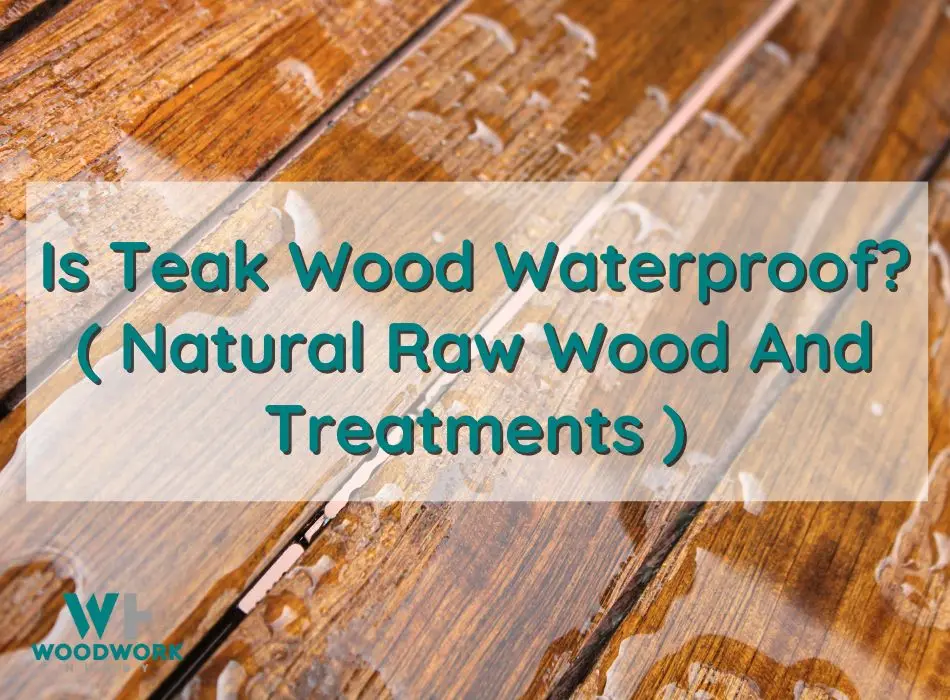I found two dozen teak boards in my shed. They have been in the backup shed for at least two years. The place gets wet a lot. Fortunately, Teak is practically waterproof, and these boards were not damaged. I had assumed some form of deterioration would have occurred in two years. But to my surprise, they were dry and in shape. So I got curious and started researching how far Teak can resist water.
Teak is practically waterproof as long as the water isn’t forced into its grain with pressure, and there is an opportunity for the water to evaporate. It can get damaged if it is underwater for extended periods, but it has resilience in the context of rain, moisture, and water splashes.
In this article, you will learn more about the extent to which Teak is waterproof and what that means for woodworking and teak furniture ownership. You will also discover ways to make Teak more waterproof than it already is.
By the end of this post, you will know everything about Teak’s water exposure capacity and waterproofing practices. But first, let’s start with how waterproof Teak is.
Can Teak Wood Get Wet?
Teak wood can get wet as it doesn’t warp or rot because of water. It has the ability to get wet without absorbing excess water because of its oil content. All the effects of water damage come from the absorption of water, which means that Teak is generally safe when it gets wet.
In my twenty years of woodworking, I have come across a handful of problems caused by water exposure. None of them apply to Teak, as you can see in the list below.
- Teak wood does not rot – Wood rots after it absorbs water in excess. Teak oil saturates the wood, so it doesn’t have the capacity to absorb enough water to cause this issue.
- Teak wood does not warp – Warping occurs when liquid leaves an absorbent solid at an uneven rate, drying some parts more quickly than others. Teak wood’s oil content doesn’t evaporate, so the wood retains its proportions and size.
- Teak wood does not soften – Teak is durable and doesn’t fall apart upon coming in contact with water because of its closed grain pattern.
- Teak wood does not get mold – Mold is an organic, living thing that needs warmth and dampness that teak wood just does not provide.
From the points above, it might seem like you can put Teak in any water-adjacent context, and it will come out just fine. So it is natural for you to wonder whether Teak is rain-proof as well.
See how to identify Teak wood with my handy guide that’s full of real-life images.
Can You Leave Teak In The Rain?
You can leave Teak in the rain without any risk of water damage. The oil content of teak wood saturates the grain, so the wood cannot absorb enough water to rot. And the water that the teak wood receives evaporates without warping the wood.
The key point here is evaporation. As long as the water that’s on teak wood goes away, the wood is fine. But if you put a teak plank inside a swimming pool and leave it for a year, of course, it will be adversely affected.
Teak is not 100% waterproof, but it can remain relatively unaffected by water exposure, provided that there is some way to dry the water. Fortunately, that way is the sun in the context of outdoor furniture.
Is Teak Wood Good For Outdoor Furniture?
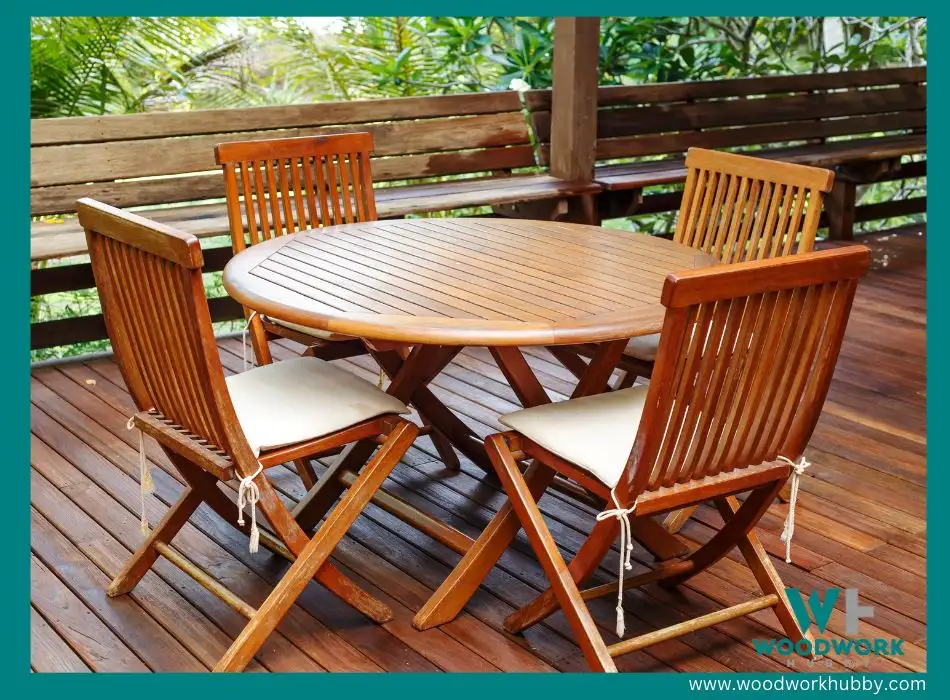
Take wood is good for outdoor furniture in places where it rains. Teak can be resilient in the face of high humidity, rainfall, and snow. It is also pest-proof for the most part, thanks to its natural oils.
That said, you might witness some teak wood degradation if it is placed outdoors in a place where there isn’t enough sunshine. Repeated rainfall can drench the wood, and without appropriate sunlight, the wood can get slightly weaker.
If you’re sure that the use case for which you choose Teak will have too much water exposure even for Teak, then you should take additional steps to protect the wood from water.
How To Protect Teak Wood From Water?
You can protect teak wood by saturating it with extra teak oil or by using a teak sealer to keep the existing teak oil from leaving the wood. Aside from using a sealer or teak oil, you can also minimize the Teak’s water exposure, cutting out any unnecessary uses that subject the Teak to wetness and humidity.
The last solution is valid only when it is practical. Of course, you cannot minimize water exposure if you plan to use teak wood in your shower.
Can Teakwood Stay In A Shower?
Teak wood can stay in a shower as long as you have a decent exhaust system. With proper ventilation, teak furniture can be dried after it gets wet in the shower. It doesn’t warp or lose its structural integrity when it is used in a shower.
What happens when Teak gets wet?
When Teak gets wet, a very tiny portion of the water ventures into the grain that isn’t already saturated with oil. Since most of the teak wood structure is rich in teak oil, the water doesn’t get very far.
Water and oil don’t mix, so the water is repelled and stays around the surface until it is evaporated because of the sunlight or air circulation.
This has a nominal effect on the wood. But if it happens repeatedly, especially after the teak wood oil begins to dry up, the water exposure can start taking its toll. The best way to avoid this outcome is to protect the Teak before it loses its water resistance.
How to extend teak wood lifespan outdoors?
You can extend the Teak’s lifespan by lightly sanding it, soaking it in teak oil, and sealing it with a teak sealer. This combination reinforces Teak’s natural defenses and ensures that it doesn’t get weak for outdoor use.
Do You Need To Waterproof Teak Wood?
You do not need to waterproof teak wood, but you might want to preserve the Teak’s natural waterproofing by sealing it. Teak wood can resist water as long as the water isn’t forced into its grain.
So the only context where water can damage Teak is when Teak is submerged in a body of water, and the pressure of the water forces its way into the grain of the wood. In that context, no type of waterproofing treatment can save the wood, though.
The pressured exposure occurs in the ocean or inside a pool. Teak cannot withstand such pressure and lets water in. Any kind of waterproofing treatment won’t make the wood resilient enough for it to be used in the ocean.
If the waterproofing treatment doesn’t make Teak good enough to be used underwater, then what does it do? Waterproofing treatment makes Teak last even longer than it lasts in exterior use cases. Outdoor teak furniture lasts 75 years without any waterproofing, but in the weather where it doesn’t get to dry off properly, its longevity is reduced.
How To Waterproof Teak For Outdoor Use?
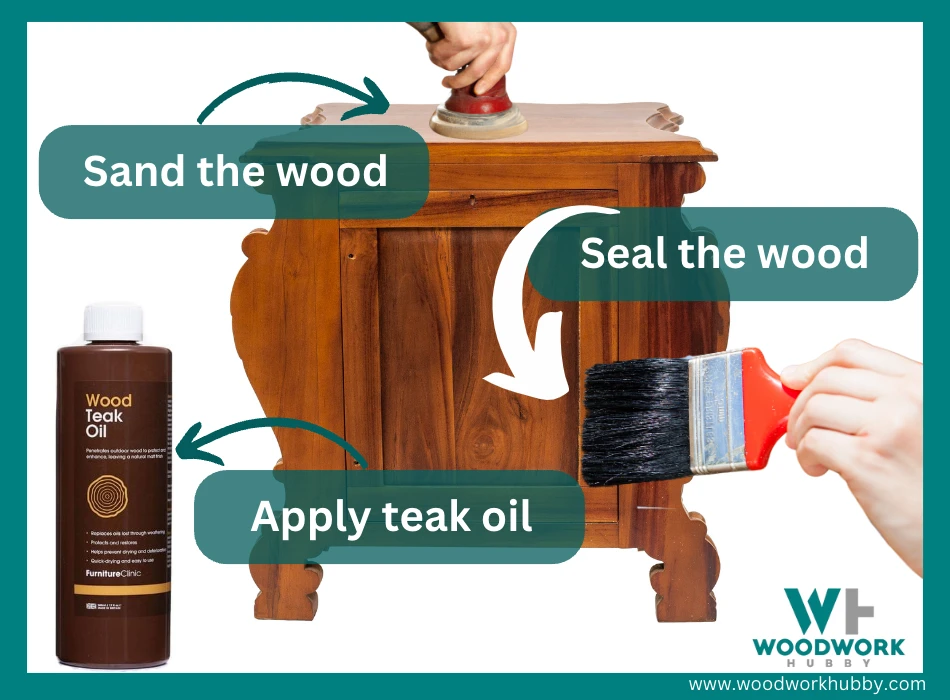
To waterproof Teak for outdoor use, you need to assess the extent of waterproofing required, sand the wood, add teak oil to fortify it, and seal it with a teak wood sealer.
These steps increase the water resistance of teak wood in gradual steps. So let’s look at each of the steps in detail.
Assess The Same Extent Of Waterproofing Required
The first step in waterproofing teak wood for exterior use is to check whether the wood even needs to be fortified in the first place. Teak wood is highly water-resistant wood that can breathe with the change of seasons without warping. It can also fend off insect attacks with its pest-repellent natural oils.
You do not need to waterproof natural teakwood in the following contexts:
- Teak wood outdoor furniture – Teak wood is naturally waterproof enough to handle exterior moisture and even rain. Unless you live in a place where the sun literally doesn’t shine, teak wood furniture is ready to use without extra finishing and waterproofing.
- Teak wood fences – Teak wood fences are not meant to be at their aesthetic best. To the extent that they need to be functional, they can hold up without additional waterproofing.
- Teak wood patio – Teak wood is used as patio material without finishing and sealing. Some homeowners choose to seal their patios. This goes on to prove that fortifying the teakwood patio with oils and sealant is an optional step.
You might need to further waterproof natural teakwood in the following contexts:
- Teakwood siding (especially close to water pipes) – Teakwood siding can get wet and be away from direct sunlight. As a result, it can remain perpetually wet and weaken over time. If your plumbing runs across the side or along the roof, then your house’s exterior siding should be waterproof.
- Teak roofing shingles and shakes – Shingles and shakes made from teak wood might need additional waterproofing if your house is located in a perpetually damp region.
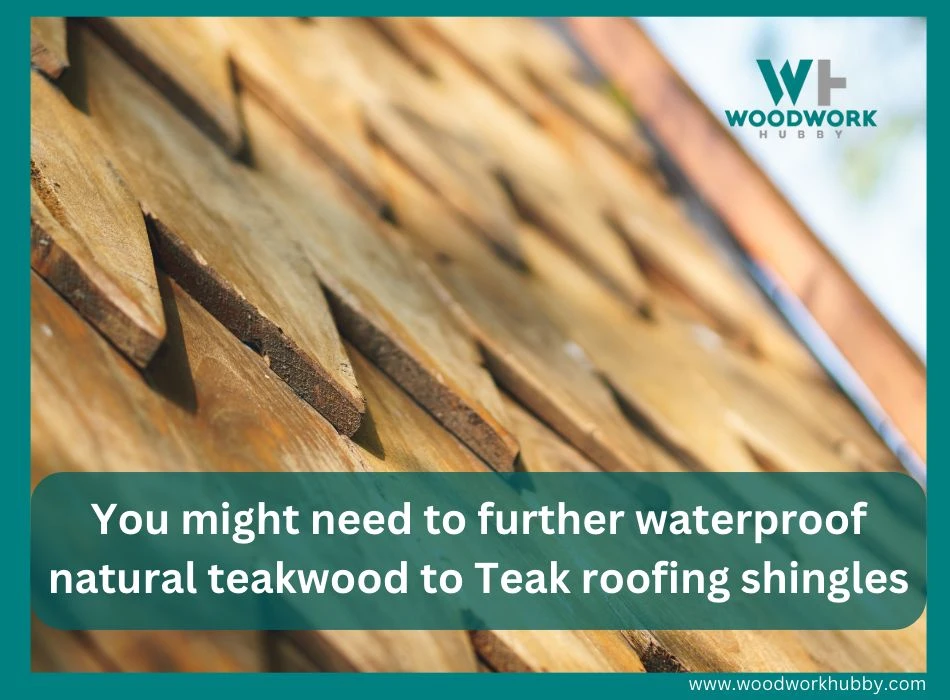
Sand The Wood To Refresh It
Once you have decided that the teak wood needs better waterproofing than it is naturally equipped with, you can start by sanding the lumber. This, of course, works better for project wood than finished projects.
When you strip away the excess dead teak wood, the inner layers are exposed. And these layers are closer to the oily core, so they are better at resisting water and repelling insects.
Add Teak Oil To Fortify The Wood
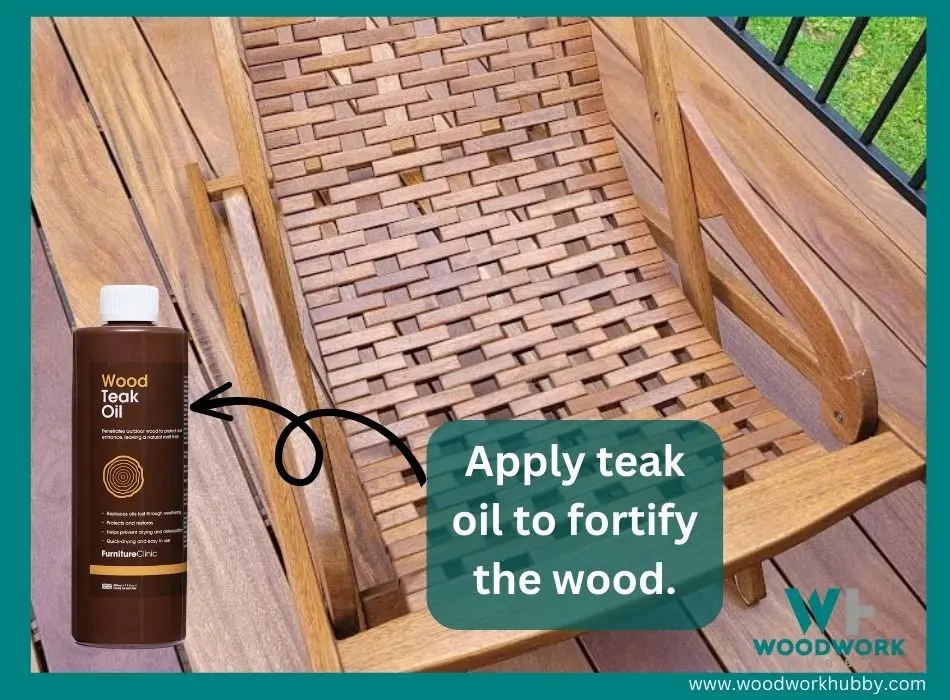
In some cases, sanding the wood won’t make too much of a difference. This is usually the case when the teak wood project is left outside for years. You can use teak wood oil like FurnitureClinic Teak Oil to fortify such projects and improve their water resistance in the process.
FurnitureClinic Teak Oil
Highly recommended wood protection
- Protect and restore your indoor and outdoor teak wood products from sun rays and other causes of aging or wear and tear.
- Easy to use and apply with the added benefit of being fast drying.
- Helps to prevent further drying, warping, and splitting by reversing any signs of deterioration in their tracks.
- 4.6 ⭐⭐⭐⭐⭐
The FurnitureClinic teak oil is a high-quality natural oil that simply replaces dried-up teak wood oil. It has over 2,187 reviews and ratings, with a global collective average of 4.6 stars on a 5-star scale.
More importantly, it has 5 stars for its water resistance, which emphasizes my point that it is the key waterproofing solution for old teak wood.
Use A Teak Wood Sealer To Seal The Oil Content.
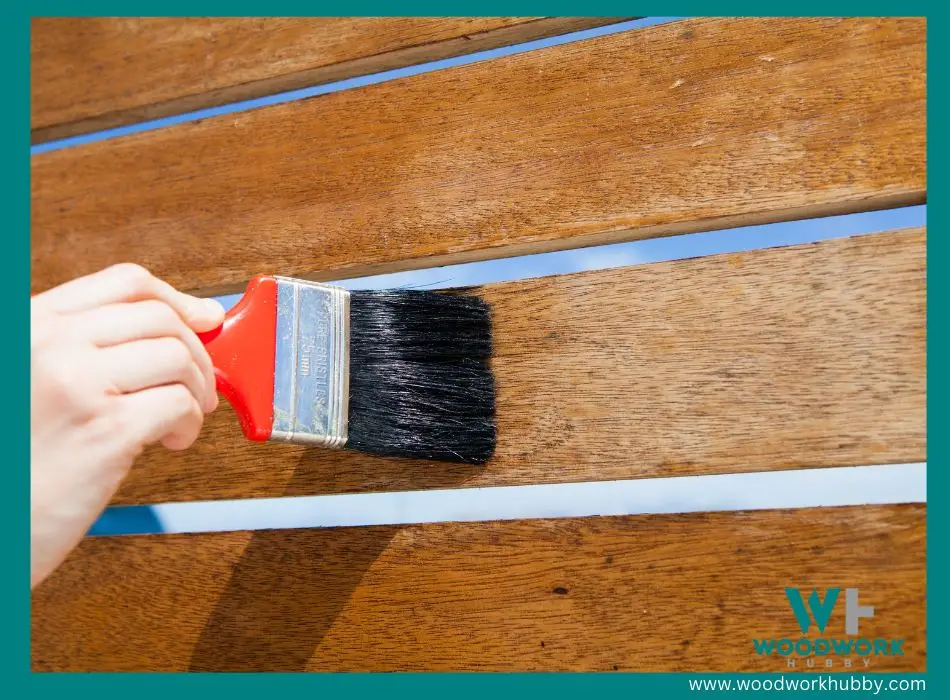
Finally, you can use a teak wood sealer which forms a layer over the teak wood, ensuring that its internal oil content doesn’t dry up yet again. This step can be executed without adding oil to teak wood if the wood in question is fresh.
Final Thoughts – Is Teak Wood Waterproof?
Teak wood is pretty waterproof in practical instances like rain exposure, moisture in the air, and water splashes. However, the oil that is responsible for its water-resistant and insect-repellent nature can dry up over the years. You can always sand the wood, add more teak wood oil, or finish it with a teak-specific sealer to further waterproof teak wood. But in most cases, you don’t have to do any of that.

